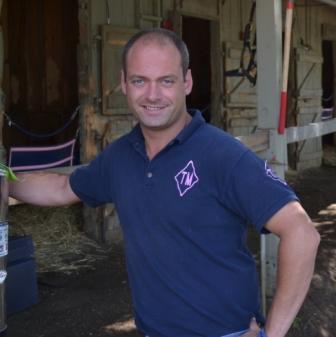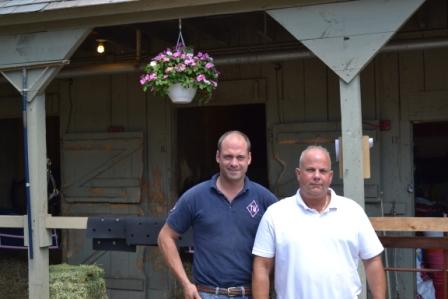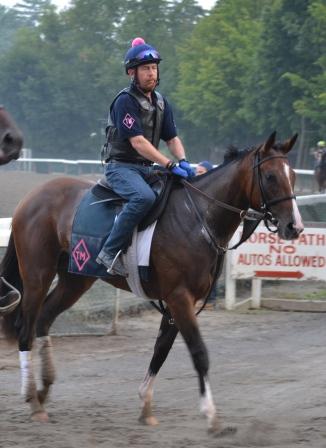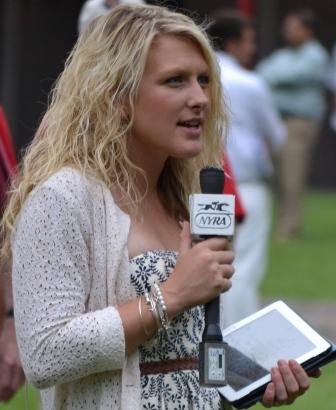Head Trainer Tom Morley – Honesty Is His Trademark
When we last visited with Tom, nearly two years ago, his stable consisted of himself, Maggie Wolfendale, one groom, one hot-walker, and about a dozen horses. Since that time, his stable has grown to around fifty horses, with 33 stabled on the grounds at Saratoga and Belmont, a dozen two-year olds in nearby training centers where Tom visits them on a regular basis, and about five older horses turned out at farms (having a mid-season break). His staff now consists of two full-time assistants, eight grooms, eight hot-walkers, and, of course, now lady of the castle – Maggie Wolfendale-Morley.
Tom Morley Stable remains a New York based operation, but will soon be expanding into other racing circuits. Tom told us “Fifty horses is a good competitive number to divide the stable”. After Saratoga, Tom plans on leaving some horses at Saratoga and moving the rest back to Belmont. In the fall, he intends to send some horses to Keeneland for the first time. Then over the winter he plans to ship a division to Florida and stable them at either Payson Park or Palm Meadows. In Florida, his two assistants, Pearl Hagadorn and Sarah O’Brien, will manage the operations while Tom runs the New York division. Tom added “In the future, when my staff has been with me longer, I wouldn’t be afraid to let the number of horses grow larger. At the end of the day, it’s not just a numbers game, but you need to have the numbers because there is always a level of attrition, when horses get hurt, sick, or taken away by an owner.”
The backbone of the Tom Morley Stable is made up of homebreds and horses purchased at yearling and two-year old sales. In discussing the horses in his barn, Tom said “We have a good mix of grass and dirt horses, but I think we are lacking a little bit in long-distance dirt horses. I tried to focus on that in the two-year old sales this year, buying horses that are bred to go a mile or longer on the dirt”. The amount of grass horses in his barn and the absence of grass racing during the winter in New York convinced Tom that it was time to send some horses south. He believes that owners will be more inclined to send turf-meant horses to him if they know the opportunity exists for them to race on the turf year round.
Tom has become much more active in helping owners in the process of purchasing horses. Tom explained “We have developed a very thorough process. I attend the Breeze shows and viewing days creating a list of horses I am interested in. Our blood-stock agent, Conor Foley, does a lot of slow-motion replay watching on the horses. If a horse makes his list and my list, then we go to look at the horse three or four more times. Finally, they are vetted and if they pass, we assign a value to the horse to make sure that the owner doesn’t spend more than that. Conor is someone I trust immensely. We went through the Darley Flying Start program together and we’ve had a lot of success with the horses we bought at the sales. He is an integral part of the team – both at the sales and for private purchases.”
One of the challenges in selecting horses to purchase is evaluating the mental state of the horse at the sales. Tom describes the horses this way, “The babies at the sales are already in an incredibly fragile mental state. They have been asked to run a faster eighth of a mile than they will ever be asked to run again, at a very early stage of their life.”
Tom explained that in a sale with 1200 horses in it, a horse might breeze on the first day followed by four days of breeze shows and three days of viewing. He adds, “These horses have gone from being fit to breeze to have a week of just showing. That can play with their minds a lot. I am looking for a horse who is always composed and does what is asked of him: walk, stand, don’t rear-up, or be sweaty in the sales ring.” For example at the April sales, Tom had two horses on his list but after watching them in the back room before the sale, he changed his mind. He said, “One of them flipped over and the other one was completely washed out and a mess.” Needless to say, Tom and the owners did not bid on those horses. Evaluating the mental side is very important because it allows Tom the opportunity to see how a horse will handle the training track with countless horses running around them and how they will handle the pressure of being in the paddock once they get to the races.
Once a horse has been purchased at the sale, Tom explains “they are sent to a farm where they do very light training in the morning and are turned out in the paddock or walked the rest of the day. We want them to get over the sales, these are an enormously stressful thing for two year-olds and we want them to know that is not what the rest of their life is going to be about.”
When I spoke with Tom two years ago, he referred to horse racing and trainers as being somewhat of a “closed shop”. To combat this perception, Tom has made a sincere effort to open up the doors to his stable and allow people to see what goes on “behind the curtain”. One of the ways he does this is embracing social media, in particular, Twitter.
He feels Twitter can be a great communication tool to reach people who are interested in the stable and his horses or those who might want to get involved in the stable at an ownership level. For example, one of the ways he does this is by routinely tweeting comments about his horses on the days they are racing. Tom said, “I try to give an honest and levelheaded opinion of what might be going to happen that afternoon or what I think happened during the race. For example, Amazing Anne ran third in a race at the Belmont spring meet. We had a very heavy rain storm that morning and I felt the ground was a little bit dead. Junior (Alvarado) and I felt the filly did not handle the ground as well as she does a firm course. I felt this was important information and explained why she finished third even though she was second-favorite, and why she was beaten by ten lengths. You can be honest and offer up an opinion after the race as much as you can before the race.” In addition to Twitter, Tom has restarted his blog on his website. It can be found at www.tommorleyracing.com.
Tom takes the same honest and open approach with his owners. He tells them right up front that he runs an open shop and invites them to visit their horses at any time. While the majority of his owners likely appreciate his candor, it has actually caused him to lose an owner on occasion. For example, Tom told us “I was fired by one owner for being too honest with him. He couldn’t handle the fact that his horse wasn’t a superstar and he wanted to run his horse in a race where the horse had no chance. Sadly, the horse was taken away. It’s possible this type of owner will go through two or three other trainers and eventually realize that at least Tom Morley was being honest with me and that my horse wasn’t Secretariat. Maybe then he’ll decide to give me another chance because I told him the truth from the word go and that is all I want to do. ” Tom wants his owners to know that if they have decided to use him as their trainer, he is not going to tell them something that is not true. Tom says “If your horse is slow, we are not going to spend two years training it because it is not going to get any quicker. It is in the owner’s interest to know their horse is slow.”
A big change in the personal life of Tom Morley happened on June 13, 2015 when he married Maggie Wolfendale (paddock analyst for NY Racing Association). When asked how this has affected Maggie’s role at Tom Morley Stable, Tom replied, “To be honest, being married to Maggie hasn’t changed anything. She is still one of my leading riders on some of the best horses in the barn and, honestly, she’s becoming better and better on the horses and her feedback is invaluable to me.” Maggie continues her afternoon position at NYRA and she must remain professional at all times, including being honest when commenting on Tom’s horses in a race. Tom explains, “She might not comment on 8 of 10 horses that I run, but that might be because she does not have anything to add to what she has said before. Maybe they are 15 to 1 and she only has a small window of opportunity and can’t talk about every horse.”
However, when given the opportunity, Maggie does not hesitate to talk about Tom’s horses. Tom said, “Just the other day, Noble Cornerstone was in the paddock and Maggie said I have to comment on him, he’s 100 pounds heavier and looks incredible. The comments she made were hugely objective. I expect nothing less than that because she is a professional. She does receive a fair amount of social media abuse, and I call it abuse, over things like her commenting that one of my first-time starters might need a race, but then he won the race. Fortunately, she has thick skin, takes a deep breath and deals with it. Our relationship has definitely not made her life easier and I tell her, ‘don’t ever let what you and I have ever change the way you do your job,’ because she does a bloody good job. It’s just one of the challenges her and I have to deal with, so we get on with it, we do it with a smiling face, and that’s what’s important.”

Modeled after European style turf courses, come visit the only one of its kind in North America. The author had a truly enjoyable visit to this unique race course the past two years. Click here to read more about last year’s adventure.





6 comments on “Head Trainer Tom Morley – Honesty Is His Trademark”